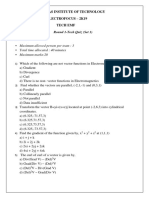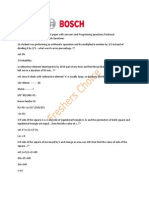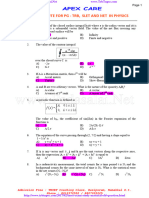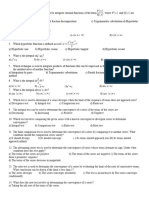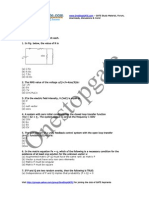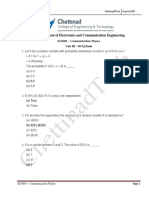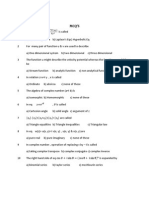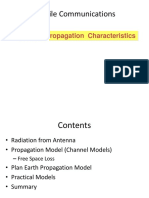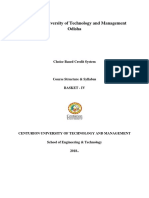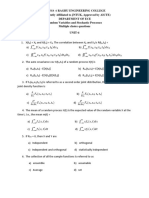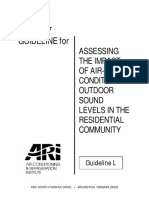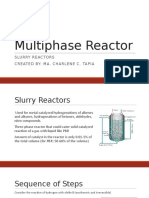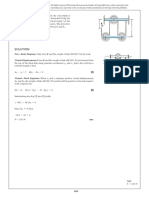0 ratings0% found this document useful (0 votes)
170 viewsChapter 5 Multiples
Chapter 5 Multiples
Uploaded by
muralitejas1. The document contains 50 multiple choice questions related to random variables and stochastic processes. Specifically, the questions cover topics like power spectral density, autocorrelation, Wiener-Khinchin relations, stationary and wide-sense stationary processes, and properties of spectral density functions.
2. The questions test understanding of key concepts such as the Fourier transform relationship between the autocorrelation function and power spectral density, properties of power spectral density for wide-sense stationary processes, and interpretations of spectral density as it relates to the distribution of power or energy over frequency for a random signal.
3. Correct answers are provided for each multiple choice question to enable self-assessment of understanding random process analysis concepts.
Copyright:
© All Rights Reserved
Available Formats
Download as DOCX, PDF, TXT or read online from Scribd
Chapter 5 Multiples
Chapter 5 Multiples
Uploaded by
muralitejas0 ratings0% found this document useful (0 votes)
170 views8 pages1. The document contains 50 multiple choice questions related to random variables and stochastic processes. Specifically, the questions cover topics like power spectral density, autocorrelation, Wiener-Khinchin relations, stationary and wide-sense stationary processes, and properties of spectral density functions.
2. The questions test understanding of key concepts such as the Fourier transform relationship between the autocorrelation function and power spectral density, properties of power spectral density for wide-sense stationary processes, and interpretations of spectral density as it relates to the distribution of power or energy over frequency for a random signal.
3. Correct answers are provided for each multiple choice question to enable self-assessment of understanding random process analysis concepts.
Original Title
CHAPTER 5 MULTIPLES.docx
Copyright
© © All Rights Reserved
Available Formats
DOCX, PDF, TXT or read online from Scribd
Share this document
Did you find this document useful?
Is this content inappropriate?
1. The document contains 50 multiple choice questions related to random variables and stochastic processes. Specifically, the questions cover topics like power spectral density, autocorrelation, Wiener-Khinchin relations, stationary and wide-sense stationary processes, and properties of spectral density functions.
2. The questions test understanding of key concepts such as the Fourier transform relationship between the autocorrelation function and power spectral density, properties of power spectral density for wide-sense stationary processes, and interpretations of spectral density as it relates to the distribution of power or energy over frequency for a random signal.
3. Correct answers are provided for each multiple choice question to enable self-assessment of understanding random process analysis concepts.
Copyright:
© All Rights Reserved
Available Formats
Download as DOCX, PDF, TXT or read online from Scribd
Download as docx, pdf, or txt
0 ratings0% found this document useful (0 votes)
170 views8 pagesChapter 5 Multiples
Chapter 5 Multiples
Uploaded by
muralitejas1. The document contains 50 multiple choice questions related to random variables and stochastic processes. Specifically, the questions cover topics like power spectral density, autocorrelation, Wiener-Khinchin relations, stationary and wide-sense stationary processes, and properties of spectral density functions.
2. The questions test understanding of key concepts such as the Fourier transform relationship between the autocorrelation function and power spectral density, properties of power spectral density for wide-sense stationary processes, and interpretations of spectral density as it relates to the distribution of power or energy over frequency for a random signal.
3. Correct answers are provided for each multiple choice question to enable self-assessment of understanding random process analysis concepts.
Copyright:
© All Rights Reserved
Available Formats
Download as DOCX, PDF, TXT or read online from Scribd
Download as docx, pdf, or txt
You are on page 1of 8
RAGHU ENGINEERING COLLEGE
(Permanently Affiliated to JNTUK, Approved by AICTE)
DEPARTMENT OF ECE
Random Variables and Stochastic Processes
Multiple choice questions
UNIT-5
1. The Fourier transform of autocorrelation function is
a) Covariance
b) Power spectrum density
c) Average power
d) None
2. For a WSS process power spectral density is
a) Non-negative
b) Negative
c) Both positive and negative
d) finite
3. Power density spectrum is
a) Complex function
b) Real function
c) Both a&b
d) None
4. Power density spectrum of a real process X(t) is
a) Even function
b) Odd function
c) Both a&b
d) None
5. Power density spectrum SXX(ω) at ω=0
a) Average power
b) Mean value
c) Mean square value
d) Area under autocorrelation curve
6. For a WSS process the Power density spectrum SXX(ω) and autocorrelation RXX(τ) are
Fourier transform pairs. this is called
a) Dirichlets conditions
b) Central limit theorem
c) Wiener –khintchine relations
d) None
7. The spectral components of X(t) are clustered at origin,then the process is
a) Lowpass
b) Highpass
c) Bandpass
d) Baseband
8. The spectral components of X(t) are clustered near some frequencies, then the process is
a) Lowpass
b) Highpass
c) Bandpass
d) Bandstop
9. The following is true in cross psd
a) Real part is even
b) Real part is odd
c) Imaginary part is even
d) Imaginary part is odd
10. The time average of the autocorrelation function and the psd form
a) Fourier Transform
b) Laplace Transform
c) Z-Transform
d) Convolution
11. The real and imaginary parts of SXX(ω) is an ___ and ____ function of ω respectively
a) Odd,odd
b) Odd,even
c) Even,odd
d) Even,even
12. If X(t) and Y(t) are orthogonal then
a) SXY(ω) = 0
b) SXY(ω) = 1
c) SXY(ω) >1
d) SXY(ω) <1
13. The cross spectral density SYX(ω) =
a) SXY(ω)
b) SXY(-ω)
c) SYX(-ω)
d) -SYX(ω)
14. 𝑅𝑋𝑋 (𝜏) = 4 + 𝑒 −2|𝜏| the area enclosed by psd is
a) 2
b) 8
c) 4
d) 6
15. 𝑅𝑋𝑋 (𝜏) = 𝑒 −3|𝜏| then psd is
6
a) 9+𝜔 2
9
b) 6+𝜔 2
3
c) 9+𝜔 2
9
d) 3+𝜔 2
16. 𝑅𝑋𝑋 (𝜏) = 10 + 5cos(2𝜏) + 10𝑒 −2|𝜏| the average dc power is
a) 5
b) 10
c) 15
d) 25
17. 𝑅𝑋𝑋 (𝜏) = 10 + 5cos(2𝜏) + 10𝑒 −2|𝜏| the average ac power is
a) 5
b) 10
c) 15
d) 25
18. 𝑅𝑋𝑋 (𝜏) = 10 + 5cos(2𝜏) + 10𝑒 −2|𝜏| the average power is
a) 5
b) 10
c) 15
d) 25
19. The mean square value of a WSS process equals
a) Area under psd
b) Area under autocorrelation
c) Zero
d) Mean of the process
20. A random process Z(t) = AX(t)+BY(t) and the processX,Y are uncorrelated then SZZ(ω)
is
a) A2+B2
b) 0
c) A2SXX(ω)+B2 SYY(ω)
d) 1
21. A random process Z(t) = AX(t)+BY(t).The cross power spectrum SXZ(ω)is
a) ASYX(ω)+ BSYY(ω)
b) ASXX(ω)+ BSYY(ω)
c) ASXX(ω)+ BSXY(ω)
d) ASYY(ω)+ BSXY(ω)
22. A random process Z(t) = AX(t)+BY(t).The cross power spectrum SYZ(ω)is
a) ASYX(ω)+ BSYY(ω)
b) ASXX(ω)+ BSYY(ω)
c) ASXX(ω)+ BSXY(ω)
d) ASYY(ω)+ BSXY(ω)
23. The psd SXX(ω) has significant components clustered in bandwidth B Hz.The process is
a) Narrow band
b) Bandpass
c) Bandlimited
d) Stationary
24. The average power is
a) RXX(1)
b) E[X(t)]
c) RXX(0)
d) E[X(t)]2
4
25. 𝑅𝑋𝑋 (𝜏) = 25 + the second order moment about origin is
1+6𝜏2
a) 28
b) 30
c) 25
d) 29
26. Psd of a random process whose autocorrelation function is 𝑎𝑒 −𝑏|𝜏|
2𝑎𝑏
a) 𝑏 2 +𝜔2
2𝑎𝑏
b) 𝑎2 +𝜔2
𝑎
c) 𝑎2 +𝜔2
𝑎𝑏
d) 𝑎2 +𝜔2
27. The collection of all sample functions is referred to as
a) Set
b) Average
c) Sample
d) Ensemble
28. The autocorrelation of X(t) = 𝑘𝑒 −𝑘|𝜏| is
1+(𝜔⁄𝑘)2
a) 2
b) 1 + (𝜔⁄𝑘 )2
2
c) 1+(𝜔⁄𝑘)2
1
d) 1+(𝜔⁄𝑘)2
29. Two processes are called orthogonal if
a) RXY(t1,t2)=1
b) RXY(t1,t2)=0
c) RXY(t1,t2)<1
d) RXY(t1,t2)>1
30. A random process X(t)=Acos(ωt+θ) is stationary if
a) E[A]=1
b) E[A]=0
c) A is Gaussian with non-zero mean
d) A is Rayleigh with non-zero mean
31. Let X(t) is a WSS random process,then
a) E[x(t)]=constant
b) RXX(τ) independent of t
c) Both a,b
d) Only a
32. A random process X(t) of mean 3 is applied to a delay element.the mean of the output
process
a) 2
b) 0
c) 1.5
d) 3
33. Two processes X(t) and Y(t) are called uncorrelated if
a) CXY(t1,t2)=1
b) CXY(t1,t2)<1
c) CXY(t1,t2)=0
d) CXY(t1,t2)>1
34. A process is said to be narrow band if the band width W is ____frequency near
bandcenter.
a) Much greater
b) Much lesser
c) Twice
d) Equal
35. What does the spectral density function of any signal specify?
a) Distribution of energy or power
b) Consumption of energy or power
c) Conservation of energy or power
d) Generation of energy or power
36. The PSD of a real valued energy signal is always
a) An even (symmetric) function of frequency
b) An odd (non-symmetric) function of frequency
c) A function that is odd and half-wave symmetric
d) None of the above
37. Which function has a provision of determining the similarity between the signal and its
delayed version?
a) Auto-correlation Function
b) Cross-correlation Function
c) Both a & b
d) None of the above
38. What is Wiener-Khinchin theorem?
a) Spectral density and auto-covariance makes a fourier transform pair
b) Spectral density and auto-correlatioon makes a fourier tranform pair
c) Spectral density and variance makes a fourier tranform pair
d) None of the mentioned
39. Autocorrelation is a function which matches
a) Two same signals
b) Two different signal
c) One signal with its delayed version
d) None of the mentioned
40. Autocorrelation is a function of
a) Time
b) Frequency
c) Time difference
d) Frequency difference
41. Autocorrelation function of periodic signal is equal to
a) Energy of the signal
b) Power of the signal
c) Its area in frequency domain
d) None of the mentioned
42. Autocorrelation is a _______ function.
a) Real and even
b) Real and odd
c) Complex and even
d) Complex and odd
43. According to Parseval’s theorem the energy spectral density curve is equal to
a) Area under magnitude of the signal
b) Area under square of the magnitude of the signal
c) Area under square root of magnitude of the signal
d) None of the mentioned
44. Power spectral density function is a
a) Real and even function
b) Non negative function
c) Periodic
d) All of the mentioned
45. Where does the maximum value of auto-correlation function of a power signal occur?
a) At origin
b) At extremities
c) At unity
d) At infinity
46. Which among the below mentioned assertions is /are correct?
A. Greater the value of correlation function, higher is the similarity level between two
signals
B. Greater the value of correlation function, lower is the similarity level between two
signals
C. Lesser the value of correlation function, higher is the similarity level between two
signals
D. Lesser the value of correlation function, lower is the similarity level between two
signals
a) Only C
b) Only B
c) A & D
d) B & C
47. The ACF of a rectangular pulse of duration T is
a) a rectangular pulse of duration T
b) a rectangular pulse of duration 2T
c) a triangular pulse of duration T
d) a triangular pulse of duration 2T
48.If (𝜏) is the auto-correlation function of a real, wide-sense stationary random
process, then which of the following is NOT true?
a) 𝑅(𝜏)=𝑅(−𝜏)
b) |𝑅(𝜏)|≤𝑅(0)
c) 𝑅(𝜏)=−𝑅(−𝜏)
d) The mean square value of the process is R(0)
49. If S(f) is the power spectral density of a real, wide-sense stationary random
process, then which of the following is ALWAYS true?
a) 𝑆(0)≥𝑆(𝑓)
b) 𝑆(𝑓)≥0
c) 𝑆(−𝑓)=−𝑆(𝑓)
d) ∫𝑆(𝑓)𝑑𝑓=0
50.Consider a WSS random process X(t)=Acosωt+Bsinωt.A,B are random
variables and ω is constant.Which of the following is true
a) E[A]≠0,E[B]≠0
b) E[A]=0
c) A and B are independent
d) E[A]=0,E[B]=0
You might also like
- Example Problems 4 Master Admission ExamDocument5 pagesExample Problems 4 Master Admission ExamReddy Babu50% (2)
- Aeolian Sand and Sand Dunes PDFDocument465 pagesAeolian Sand and Sand Dunes PDFshantanuril100% (1)
- BF3 Scrubber Column DiameterDocument21 pagesBF3 Scrubber Column DiameterMuthuKumar Arunachalam0% (1)
- Pe04025 QaDocument15 pagesPe04025 QaSona Sith20% (5)
- Chapter 6 MultipleDocument8 pagesChapter 6 MultiplemuralitejasNo ratings yet
- Signals and SystemsDocument8 pagesSignals and SystemskgovindrajanNo ratings yet
- Part-I Physics FOY TEST: Name: - Roll No.: - Phone#Document8 pagesPart-I Physics FOY TEST: Name: - Roll No.: - Phone#Moiz MohsinNo ratings yet
- Signals and Systems Model Exit ExamDocument12 pagesSignals and Systems Model Exit ExamZerubabel FasikaNo ratings yet
- Tech QuizDocument3 pagesTech QuizGayathriRajiNo ratings yet
- Ss - Objective (1) - 231211 - 184644Document12 pagesSs - Objective (1) - 231211 - 184644SWATHI ECE - 039No ratings yet
- Jad Dcio CBRT 08032020 An - 1Document17 pagesJad Dcio CBRT 08032020 An - 1AdityaNo ratings yet
- Control Mock TestDocument3 pagesControl Mock TestsafiyaNo ratings yet
- GATE (Electronics and Communication Engineering) Exam Sample Paper 6Document24 pagesGATE (Electronics and Communication Engineering) Exam Sample Paper 6Prudhvi BadeNo ratings yet
- MCQ Set1 PTSPDocument2 pagesMCQ Set1 PTSPPrabhakara RaoNo ratings yet
- Subject: Signals & SystemsDocument27 pagesSubject: Signals & SystemsNaga VardhanNo ratings yet
- Gate Me - 2005Document15 pagesGate Me - 2005veer_sNo ratings yet
- Control System MCQDocument9 pagesControl System MCQAlka GoyalNo ratings yet
- McqsDocument15 pagesMcqsPriyansu Singh100% (2)
- GATE (2012) Question Paper Electronics Electrical 18494Document15 pagesGATE (2012) Question Paper Electronics Electrical 18494Uday KumarNo ratings yet
- DSP Module 1 - 2 Mark - QuestionDocument3 pagesDSP Module 1 - 2 Mark - QuestionAbhishek PandeyNo ratings yet
- Electromagnetic Field Theory: A Problem Solving ApproachDocument11 pagesElectromagnetic Field Theory: A Problem Solving ApproachahmdNo ratings yet
- DSP MCQ With Answer-Unit IDocument9 pagesDSP MCQ With Answer-Unit IAbineshNo ratings yet
- Techno India Batanagar Basic Science and Humanities Model QuestionsDocument12 pagesTechno India Batanagar Basic Science and Humanities Model QuestionsAndre SaputraNo ratings yet
- Signals and Systems - MCQ: B. SamplingDocument11 pagesSignals and Systems - MCQ: B. Samplingpavithra PNo ratings yet
- PG TRB Physics Fulltest - 5 - K.s.academy SalemDocument18 pagesPG TRB Physics Fulltest - 5 - K.s.academy SalemBaskar Cyril100% (1)
- Robert Bosch Placement Paper 1 - Freshers ChociDocument11 pagesRobert Bosch Placement Paper 1 - Freshers ChocifresherschoiceNo ratings yet
- Tnset Physics Study Material 9Document7 pagesTnset Physics Study Material 9NiveCeciliaNo ratings yet
- Gate Mock Test1Document17 pagesGate Mock Test1Gopinathan SudheerNo ratings yet
- Antenna and Wave Propagation MCQ CompleteDocument359 pagesAntenna and Wave Propagation MCQ CompleteAkshita ChhabraNo ratings yet
- Robert Bosch Placement Pattern 2 - Freshers ChoiceDocument14 pagesRobert Bosch Placement Pattern 2 - Freshers ChoicefresherschoiceNo ratings yet
- Continuous Assessement: 2019/2020 Academic Year: Course Title: Digital Control Systems. Course Code: Eeep3201Document3 pagesContinuous Assessement: 2019/2020 Academic Year: Course Title: Digital Control Systems. Course Code: Eeep3201Danny JrNo ratings yet
- CVVDocument6 pagesCVVappuamreddyNo ratings yet
- Microprocessors:: PIEAS MS Test (Electronics Portion 2016)Document6 pagesMicroprocessors:: PIEAS MS Test (Electronics Portion 2016)Usama IbrahimNo ratings yet
- MCQ For PTSPDocument11 pagesMCQ For PTSPDr. Hemant Kumar Gupta100% (1)
- Question Bank DSP: Preparatory Guidebook For Comprehensive ExaminationDocument6 pagesQuestion Bank DSP: Preparatory Guidebook For Comprehensive ExaminationMisbah Sajid ChaudhryNo ratings yet
- Paper 1Document3 pagesPaper 1sharmeenabdullah12No ratings yet
- Maths Remedial Exam (2015)Document9 pagesMaths Remedial Exam (2015)johnd3von88No ratings yet
- QB - Signal & SystemDocument17 pagesQB - Signal & Systemerdeep2020No ratings yet
- GATE Study Material, Forum, Downloads, Discussions & More!Document17 pagesGATE Study Material, Forum, Downloads, Discussions & More!vims124No ratings yet
- MCQ Unit 5Document6 pagesMCQ Unit 5Sandesh KaleNo ratings yet
- Gate - in 2007Document30 pagesGate - in 2007prabhjot singh1No ratings yet
- (WWW - Entrance-Exam - Net) - GATE ECE Solved Paper - 2003Document20 pages(WWW - Entrance-Exam - Net) - GATE ECE Solved Paper - 2003Nandha KumarNo ratings yet
- BoschDocument28 pagesBoschBhargav Jyaganti100% (1)
- (WWW - Entrance-Exam - Net) - GATE Instrumentation Engineering Sample Paper 1Document13 pages(WWW - Entrance-Exam - Net) - GATE Instrumentation Engineering Sample Paper 1Rajni KantNo ratings yet
- Ar Adl - : Answer: (C)Document17 pagesAr Adl - : Answer: (C)smrahimNo ratings yet
- Answer: (B) : EE-GATE-2013 PAPERDocument16 pagesAnswer: (B) : EE-GATE-2013 PAPERకృష్ణ మురళిNo ratings yet
- 90 Minutes: Ij Ij Ji Ij Ji Ij Ji Ij JiDocument11 pages90 Minutes: Ij Ij Ji Ij Ji Ij Ji Ij JiRandeep Iyyad N CNo ratings yet
- The PSD of The Random Process X (T) With Mean I andDocument11 pagesThe PSD of The Random Process X (T) With Mean I andHarini VemulaNo ratings yet
- Mock ExamDocument20 pagesMock ExamkandulanageshNo ratings yet
- Answer: (C) : - EC-GATE-2013 PAPERDocument9 pagesAnswer: (C) : - EC-GATE-2013 PAPERP KNo ratings yet
- Ece503 ps04Document5 pagesEce503 ps04Rushabh MehtaNo ratings yet
- GATE Question Papers Electronics and Communication Engineering 2007Document17 pagesGATE Question Papers Electronics and Communication Engineering 2007asiffarookiNo ratings yet
- BE Electronics and Telecommunication Engineering PDFDocument670 pagesBE Electronics and Telecommunication Engineering PDFRahul TadeNo ratings yet
- RMT PDFDocument136 pagesRMT PDFDipen ChavanNo ratings yet
- Department of Electronics and Communication Engineering: EC8491 - Communication Theory Unit III - MCQ BankDocument9 pagesDepartment of Electronics and Communication Engineering: EC8491 - Communication Theory Unit III - MCQ Bankrasha hassanNo ratings yet
- GATE-Electronics & Comm (ECE) - 2008Document29 pagesGATE-Electronics & Comm (ECE) - 2008Shirshendu PanditNo ratings yet
- Et 4235 Digital Signal ProcessingDocument4 pagesEt 4235 Digital Signal ProcessingMichelNo ratings yet
- 2 qp2Document13 pages2 qp2JustinNo ratings yet
- P, P Z (O / P) OFF OFF OFF OFF ON ON ON OFF ON ON ON OFF: EC-GATE-2013 PAPERDocument31 pagesP, P Z (O / P) OFF OFF OFF OFF ON ON ON OFF ON ON ON OFF: EC-GATE-2013 PAPERa_barbate1147No ratings yet
- Compex 2Document4 pagesCompex 2Aman BhuttaNo ratings yet
- Student Solutions Manual to Accompany Economic Dynamics in Discrete Time, second editionFrom EverandStudent Solutions Manual to Accompany Economic Dynamics in Discrete Time, second editionRating: 4.5 out of 5 stars4.5/5 (2)
- Fundamentals of Digital CommunicationDocument64 pagesFundamentals of Digital CommunicationmuralitejasNo ratings yet
- FSM and Efficient Synthesizable FSM Design Using VerilogDocument10 pagesFSM and Efficient Synthesizable FSM Design Using VerilogmuralitejasNo ratings yet
- Smart India Hackathon 2019: Problem Statements-SoftwareDocument8 pagesSmart India Hackathon 2019: Problem Statements-Softwaremuralitejas100% (1)
- Mobile Communications: Part IV-Propagation CharacteristicsDocument63 pagesMobile Communications: Part IV-Propagation CharacteristicsmuralitejasNo ratings yet
- Basket 5 Engg Domain Courses - 2 PDFDocument357 pagesBasket 5 Engg Domain Courses - 2 PDFmuralitejasNo ratings yet
- Mobile Communication Systems: Part III-Traffic EngineeringDocument50 pagesMobile Communication Systems: Part III-Traffic EngineeringmuralitejasNo ratings yet
- Mobile Wireless Communication Systems: Part 1Document49 pagesMobile Wireless Communication Systems: Part 1muralitejasNo ratings yet
- Digital Communication TechniquesDocument5 pagesDigital Communication TechniquesmuralitejasNo ratings yet
- Digital Transmission FundamentalsDocument159 pagesDigital Transmission FundamentalsmuralitejasNo ratings yet
- Communication DomainDocument84 pagesCommunication DomainmuralitejasNo ratings yet
- Basket - IV - Electronics and Commmunication Engineering PDFDocument81 pagesBasket - IV - Electronics and Commmunication Engineering PDFmuralitejasNo ratings yet
- CHAPTER 4 Multiple QuestionsDocument8 pagesCHAPTER 4 Multiple QuestionsmuralitejasNo ratings yet
- Hand and Power Tool Safety English QuizDocument7 pagesHand and Power Tool Safety English Quizvibu vibasNo ratings yet
- LV 110 - LV 111 - LV 117: Vane Probe Thermo-AnemometerDocument4 pagesLV 110 - LV 111 - LV 117: Vane Probe Thermo-AnemometerAwan Al-AswadNo ratings yet
- Four Point LightingDocument2 pagesFour Point LightingDylanOSullivanNo ratings yet
- Sigmadur GlossDocument5 pagesSigmadur Glossgst ajahNo ratings yet
- Assignment No 4Document3 pagesAssignment No 4RitikNo ratings yet
- Ieee Editorial Style Manual: IEEE Periodicals Transactions/Journals Department 445 Hoes Lane Piscataway, NJ 08854 USADocument3 pagesIeee Editorial Style Manual: IEEE Periodicals Transactions/Journals Department 445 Hoes Lane Piscataway, NJ 08854 USAGerman RuizNo ratings yet
- Cbse Class 12th Result VishwashDocument1 pageCbse Class 12th Result VishwashVishwash SinghNo ratings yet
- Electromagnetic Waves 1 QPDocument18 pagesElectromagnetic Waves 1 QPNaeemNo ratings yet
- Pharmaceutical Dosage Forms and CalculationDocument3 pagesPharmaceutical Dosage Forms and CalculationVimala BaluNo ratings yet
- B.sc. Industrial ChemistryDocument79 pagesB.sc. Industrial ChemistryOmar Abd Elsalam50% (2)
- 02-Structure of AtomDocument100 pages02-Structure of Atomtorodoki15No ratings yet
- Free Radical ChlorinationDocument3 pagesFree Radical ChlorinationShailesh GhediyaNo ratings yet
- Quadror StructurDocument8 pagesQuadror Structurবায়েজিদ সরকারNo ratings yet
- Unit 5 Test 2014Document9 pagesUnit 5 Test 2014Sarilyn Simon0% (1)
- 1997 Guideline For: Assessing The Impact of Air-Conditioning Outdoor Sound Levels in The Residential CommunityDocument14 pages1997 Guideline For: Assessing The Impact of Air-Conditioning Outdoor Sound Levels in The Residential CommunityKartik PrabhakarNo ratings yet
- Aula8 Turb in Fluids Isotropic TurbulenceDocument47 pagesAula8 Turb in Fluids Isotropic TurbulenceTomás CarreiraNo ratings yet
- Experiment No. 1 Objective: Vernier Callipers, A Spherical Body (It Can Be A Pendulum Bob), A Beaker or A CalorimeterDocument2 pagesExperiment No. 1 Objective: Vernier Callipers, A Spherical Body (It Can Be A Pendulum Bob), A Beaker or A CalorimeterShivam YadavNo ratings yet
- CO PHYS1110 1 2024 Term2 T2 Online Standard KensingtonDocument13 pagesCO PHYS1110 1 2024 Term2 T2 Online Standard Kensington18521564No ratings yet
- On The Design of X-Bow For Ship Energy Efficiency: M. A. Mosaad, M.M. Gafaary, W., H.M. HassanDocument3 pagesOn The Design of X-Bow For Ship Energy Efficiency: M. A. Mosaad, M.M. Gafaary, W., H.M. HassanHussien ElmasryNo ratings yet
- Pillar Design PDFDocument32 pagesPillar Design PDFsaadiaNo ratings yet
- Paper 1 - DP1 (HL)Document39 pagesPaper 1 - DP1 (HL)Youssry El-SadiNo ratings yet
- Iris RecognitionDocument26 pagesIris Recognitionprachee1ratnaparkhiNo ratings yet
- Multiphase ReactorDocument37 pagesMultiphase ReactorMaria Charlene Caraos TapiaNo ratings yet
- HW15 SolDocument9 pagesHW15 Sol張芷芸No ratings yet
- VEED Subtitles - Spider ManDocument82 pagesVEED Subtitles - Spider Manhask9999nNo ratings yet
- Fabrication and Design of Multi-Layered Radar Absorbing Structures of MWNT-filled Glass/epoxy Plain-Weave CompositesDocument9 pagesFabrication and Design of Multi-Layered Radar Absorbing Structures of MWNT-filled Glass/epoxy Plain-Weave CompositesRiston SinagaNo ratings yet
- Latihan Soal, Grammar, VocabularyDocument6 pagesLatihan Soal, Grammar, Vocabularyherman fany fancoNo ratings yet








